Despite the best efforts by the Government of India, present production of pulses is insufficient to meet the demand. In this blog, Uma Sah and Rekha Rani reflect on the challenges in enhancing pulse production in India and the role Extension and Advisory Services could play in bridging the supply-demand gap.
CONTEXT
World Pulses Day is celebrated on 10 February every year. The theme for 2024 is ‘Pulses: Nourishing People and Soils’. Pulses – the mighty seeds of leguminous plants – come in various sizes, shapes and colors within a pod; and is primarily used as food and feed for animals across India. As an integral component of the Indian food plate, pulses constitute about 10.50% of total protein intake in largely vegetarian Indian diets (68th Sample Survey 2011-12). Pulses are also an important component of the cropping systems in the country, carried out in alignment with regional preferences as well as prevailing agro-climatic conditions (Box 1).
IMPORTANCE OF PULSES
For Nourishing People
The nutrient-dense seeds of pulses are packed with low-fat protein, complex carbohydrates and high-quality dietary fiber. Pulses are also rich in nutrients, vitamins, and minerals including iron, potassium, magnesium and zinc. They are particularly abundant in B vitamins; including folate, thiamin and niacin. Compared to cereals, pulses have 1.67 times more iron, 2.47 times more protein, 3.54 times more vitamin A, and 5.31 times more dietary folate. The presence of certain essential amino acids in pulses complement those available in cereals. The protein quality of a vegetarian diet significantly improves when pulses and cereals are consumed together. The popular habit of eating pulses and rice, chapatti with pulses, and idli with pulse-infused sambhar are a few examples of this combination found in the daily Indian food platter. Consuming pulses along with vitamin-C rich foods enhances absorption of iron, making pulses a potent food for preventing anemia. Pulses, with a low glycemic index are ideal for diabetic patients. Availability of certain phytochemicals and antioxidants in pulses also play an important role in reducing the risk of cancer occurrence (Mudryi et al. 2014). Owing to their higher nutritional values, pulses are the preferred supplement for a balanced diet and also have been recommended by the Indian Council of Medical Research (ICMR) as an essential component of a balanced healthy diet. The ICMR recommends an average daily intake of about 68 g/capita/day, while the actual consumption is 53 gm /capita/day (2022).
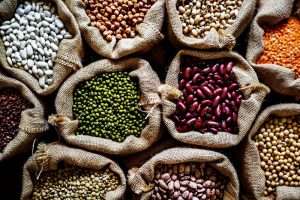
In Nourishing Soils
Pulses have immense potential for enhancing soil fertility and resource-use efficiency, thereby improving both productivity and sustainability of the production system. Moreover, they have the potential to add 26-100 kg nitrogen into the soil per hectare (Gill et al. 2009), thus improving soil fertility and yields in subsequent crops. This self-sufficiency signifies that the plant requires much less nitrogen fertilizer which thus saves the environment from greenhouse gases, a by-product of the manufacture and use of nitrogen fertilizers, thus stamping favorable ecological footprints. In a country like India, where the average consumption of plant nutrients from chemical fertilizers on a national basis is very low, the scope for exploiting direct and residual fertility through legumes has obviously great potential (Ghosh et al. 2006)
| Box 1: Pulses in India Globally India occupies the lion’s share of pulses in total area (33%) and production (22%) and is the largest supplier in the world. About a dozen pulses are produced and consumed in the country given the wide regional dietary diversity. Chickpea, pigeonpea, mungbean, uradbean, and lentil are major pulses which together contributed about 92% of total pulse production in India during 2021-22. Moreover, India is also the largest consumer and importer (about 3 MT annually) of pulses in the world. The projected requirement of pulses for domestic consumption in the country is 32 million tons by 2030 and 39 million tons by 2050. As per the estimated share of pulse production across India during 2022, Rajasthan (19.53%), Madhya Pradesh (17.84%), Maharashtra (16.23%), Uttar Pradesh (10.63%), and Karnataka (9.36%) emerged as the five major pulse-producing states in the country. (Statista, 2023) |
NATIONAL EFFORTS IN PROMOTION OF PULSES
Measures to improve pulse production
Pulses development has remained a priority of the Government of India since the Fourth Five-Year Plan (1969-70 to 1973-74) with a more focused approach from the Sixth Plan (1980-85) onwards. The National Food Security Mission (NFSM)-Pulses, one of the components of the centrally sponsored scheme of NFSM has been under implementation since Rabi2007-08 in 28 States and two Union Territories (Jammu & Kashmir and Ladakh) with the objective of increasing production of pulses through area expansion and productivity enhancement. This component has undergone several changes since its inception, and finally has taken the shape of a completely centrally-sponsored scheme on pulses by merging the various pulses development components.
The revamped NFSM program was implemented through a centrally sponsored umbrella scheme called the Green Revolution–Krishonnati Yojana– in 638 districts in the country. During 2015-16, new initiatives such as distribution of seed mini kits of quality seed, creation of seed hubs at SAUs and KVKs, enhancing breeder seed production at ICAR institutes and SAUs, strengthening of bio-fertilizers and bio agent labs at SAUs/ICAR Institutes and cluster front line demonstration by KVKs have been included under NFSM. The pulse component received financial allocations of about 60% of the total NFSM budget for this purpose.
‘Creation of seed hubs’ is one of the significant institutional innovations for ensuring pulses seed sufficiency in India, it is being implemented under the NFSM program for increasing indigenous production of pulses in India. Under this scheme, 150 seed hubs have been created across the country utilizing the synergies of ICAR, SAU and All India Coordinated Research Project (AICRP) for enhancing the availability of quality seeds of pulses in the country. Under the seed hub project, 4,66,950 quintals of quality seed and 12,931 quintals of additional breeder seeds of pulses were produced during 2017-21. Moreover, with the implementation of the above program India saw an increase in Seed Replacement Rate (SRR) of pulses from <10% in 2004-05 to >30% now.
Measures to improve pulses consumption
For ensuring nutritional security to the masses, provision was made by the government to include pulses in various schemes. Under Pradhan Mantri Garib Kalyan Anna Yojana, provisions for distribution of more than 1.2 mt of pulses (1 kg of free pulses to each household) to 195 million households, covered under the National Food Security Act (NFSA), were made during April-November 2020.
Under NFSA, states were offered pulses at the rate of Rs 15 per kg which is a discounted price over the market price of raw material, and it is supplied to meet nationwide requirements through mid-day meals at schools, ICDS nutritional support, and to the army and central paramilitary forces since October 2018- September 2019. More than a million tons of pulses were allocated to states under this pilot scheme. Furthermore, provision for giving free five kg per person of food grains to over 81 crore PDS beneficiaries in the country were made. This is over and above the quota given under the NFSA. Under the mid-day meal scheme 8-12 grams of protein per day of school for a minimum of 200 days per year has been ensured. This includes serving 20 to 30 gm of pulses per child every day.
EXTENSION AND ADVISORY SUPPORT TO PROMOTE THE PULSES SECTOR
Front Line Demonstrations (FLDs) on pulses are an approved component of NFSM for implementation by ICAR/SAUs system that conducts more than 1500 FLDs on pulses across different regions of the country. FLD is a unique methodology that facilitates direct interaction between researchers and farmers in carrying out demonstrations on technologies developed by research systems and to receive feedback from the farmers’ fields about the demonstrated technologies. This helps in finetuning the technologies for easy adaptability in farmers’ fields.
Since 2015-26, a nationwide program, Cluster Front Line Demonstrations (CFLDs) on pulses under NFSM, is being implemented by Krishi Vigyan Kendras (KVKs). The program is executed with the objective of demonstrating the production potential of major pulse crops in the main pulse growing states of the country. Since inception, every year on average 30,000 CFLDs on various pulses across all three seasons are being conducted using the network of 634 KVKs besides the cluster demonstrations by the State Department of Agriculture. More than 5.30 lakh CFLDs have been conducted so far (2022-23) covering 2.13 lakh hectares in the country, wherein about 37.43% yield enhancement could be recorded. The Indian Institute of Pulses Research (IIPR) under the Indian Council of Agricultural Research (ICAR) is also engaged in coordinating the Front Line Demonstrations (FLDs) on pulse production technologies through centers under coordinated research projects across the country (Box 2).
| Box 2: Extension efforts of ICAR-IIPR, Kanpur ICAR-IIPR Kanpur has been striving to develop methodologies to efficiently deliver the technological options for use by producers. Efforts have been made to validate different farmer centric Farmer to Farmers Extension (FFE) approaches for speedier diffusion of quality seed of pulse crops among the farming community by leveraging social networks. The group extension approaches for strengthening the formal and informal seed system of pulses was utilized by engaging farmers’ registered groups for the purpose. Moreover, an integrated farming system approach was implemented with multiple technological interventions for food, nutrition and livelihood security of rural households with inclusion of pulses, cereals, vegetables, livestock and entrepreneurship development components. The institute has done much for entrepreneurial development of farmers, farm women and farmers groups in agriculture through a dedicated Agri-Business Incubation unit. Further, significant efforts have been made to capitalize on digital technologies for reaching the pulse growers on a real time basis. In this direction, a web portal, mobile applications, videos, and a mobile-based advisory system have been utilized. |
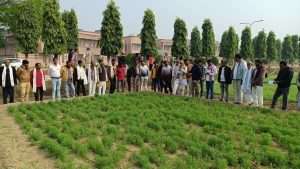 Farmers training at ICAR-IIPR, Kanpur
Farmers training at ICAR-IIPR, Kanpur
CHALLENGES IN PULSE SECTOR DEVELOPMENT
Though several efforts have been taken to promote production of pulses in the country, the sector continues to face several challenges. These are discussed below:
Vicious cycle of low production: Pulse production in India has been caught in a vicious cycle of low and uncertain yields. The lower yields of pulses led to low profitability for farmers which made farmers allocate fertile and irrigated land to cereals, thus pushing pulses to marginalized and less fertile lands. Higher yield potential of paddy and wheat as compared to pulses also add to this preference. Moreover, farmers take the least effort for proper management of pulse crops as they are considered a low-input enterprise in terms of irrigation and fertilizer application. In some areas, field preparation, sowing, and harvesting are the only operations practiced by pulse growers.
Lack of awareness on the importance of pulses for humans and soils, and availability of improved technologies: Farmers perceive pulses as having a lower cost-benefit ratio compared to competing cereal crops where yields and returns are higher. They are unaware of the indirect advantages of growing pulses, such as improved soil health, lower use of water, and reduced carbon footprints. While allocating areas to pulses, they also do not take into consideration the significance of pulses in fulfilling the daily protein needs of people, particularly women and children. Farmers’ adoption is further hampered by their ignorance of improved pulse production technologies, including improved and disease-resistant varieties.
Non availability of quality seeds: One of the biggest obstacles to the production of pulses is the non-availability of quality seeds of recommended varieties in sufficient quantities. Accessibility and affordability of seeds are important limiting factors. There has been widespread use of poor-quality farm-saved seeds with low rates of seed replacement. Over the years, the seed replacement rate has improved to more than 30% in chickpea, mungbean, lentil, uradbean, and 60% in pigeonpea (2019–20), but availability of quality seeds is still a big challenge for most farmers.
Huge yield gaps: Though the country has witnessed significant improvement in productivity of pulses mainly due to development and promotion of several technological breakthroughs, the average productivity is three-fourth of the global average. Wide variations in yield of pulses across states have also been noticed, may be due to differences in agro-climatic conditions, technology adoption, and socioeconomic factors. In most of the pulses, there is a large gap between the potential yield and the realized yield under field conditions. Pushing of pulse to the poor and marginalised areas with low resource conditions is one of the most important reasons behind poor pulses productivity in the country.
Price volatility and marketing: Farmers have been deterred by the price fluctuation in pulses which other crops such as oilseeds and cereals do not experience. Lack of secured markets for pulses also discourage farmers from growing pulses.
Pest and diseases: Among diseases, Fusarium wilt coupled with root rot disease complex is probably the most widespread disease, causing substantial yield losses in chickpea. Similarly, Fusarium wilt, sterility mosaic and phytophthora blight in pigeonpea, yellow mosaic, cercospora leaf spot and powdery mildew in both mungbean and uradbean, rust and wilt in lentil cause considerable losses. Besides the weed problem, gram pod borer in chickpea and pigeonpea, pod fly in pigeonpea, whitefly, jassids and thrips in mung bean cause severe damage to crops. Additionally, pulses are more vulnerable to insect damage during storage (5%) compared to wheat (2.5%), rice (2%), and maize (3.5%).
EFFORTS MADE TO ADDRESS THE CHALLENGES
Technological advancement: The National Agricultural Research System (NARS), under the aegis of the Indian Council of Agricultural Research (ICAR)– from 1965 onwards – has developed 1083 region-specific, high-yielding varieties of pulses insulated against major biotic and abiotic stresses. Many of these pulse varieties were developed in collaboration with the International Crops Research Institute for the Semi-Arid Tropics (ICRISAT), Hyderabad. These pulse varieties have brought significant changes in the pulse production scenario in the country. The success in chickpea production in Andhra Pradesh State of India, that was witnessed with the release of short duration variety JG 11 by NARS of India and ICRISAT jointly, is an example of a technological breakthrough in pulse production history. The short-duration varieties of mungbean are another example, which have been seeking farmers’ attention for the last few years for additional farm income.
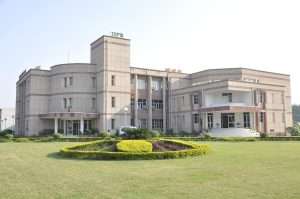 ICAR-Indian Institute of Pulses Research, Kanpur
ICAR-Indian Institute of Pulses Research, Kanpur
Awareness generation: Pulses captured the attention they deserve in 2016 when the UN General Assembly (UNGA) declared the year as the International Year of Pulses (IYP 2016).This was done with the aim of enhancing public awareness on the nutritional benefits of pulses as part of sustainable food production, aimed at food security and better nutrition. Building on the success of IYP 2016, UNGA designated February 10 as World Pulse Day. This celebration presents a unique opportunity to raise public awareness on pulses. Several campaigns, scientist-farmer interaction programs, kisan melas, etc., are the other platforms where farmers are informed about the importance of pulses for their health as well as farming.
Regulating price volatility: Assurance of a remunerative and stable price environment for farmers is very important for increasing pulses production. In this direction, price volatility has been regulated through procurement under different schemes. The National Agricultural Cooperative Marketing Federation of India Ltd. (NAFED), is one of the Central Nodal Agencies for procurement of 16 notified agricultural commodities of oilseeds, pulses and cotton under Price Support Scheme (PSS). NAFED is also procuring pulses for buffer stocking under Price Stabilization Fund (PSF) Scheme of the Government of India. In June 2023, towards boosting domestic production of pulses, the government has removed the 40% procurement ceilings for tur, urad and masur under PSS operations for 2023-24.Recently, the central government has launched the portal developed by National Agricultural Cooperative Marketing Federation of India Ltd. (NAFED)and National Cooperative Consumers’ Federation of India Limited (NCCF) for registration, procurement and payment for tur dal producing farmers.
Hike in Minimum Support Prices (MSP): In recent years, the government has been promoting the cultivation of pulses by offering a higher MSP. The government has increased the MSP of Rabi pulses, i.e., gram and lentil, from Rs. 3100/q and 2950/q, respectively, in 2014–15 to Rs. 5440/q and Rs. 6425/q, respectively, in 2024–25. The government has increased the MSP of Kharif pulses, i.e., tur, mungbean and urdbean, from Rs. 4350/q, 4600/q and 4350/q respectively, in 2014–15 to Rs. 7000/q, Rs. 8558/q and Rs. 6950/q respectively, for marketing season 2023-24. The inclusion of ecological services offered by pulses in MSP will further encourage farmers to allocate more area to pulse cultivation.
WAYS FORWARD: Strengthening the role of Extension and Advisory Services in Promoting Pulse Production
Despite the best efforts by the Government of India, pulses production in the country could only reach upto27 MT (III advance estimate 2022-23). As discussed earlier, pulses production continues to face several challenges. Extension and Advisory Services need to further intensify their efforts in promoting pulse production. The methods are discussed below:
Promote decentralized model of seed production: Decentralized seed production refers to a system where farmers as individuals or as groups produce seeds as per the mandated guidelines that are later bought by the formal seed system. This seed production model works on a win-win situation for both the farmer who produces seed as well the purchasing agency (Box 3). The farmers acquire the necessary skill sets and knowledge on the process for seed production, get an assured market for the produce, and also gets access to certified seeds for sowing in his farm. This also actually contributes to strengthen the informal seed system. On the other hand, the purchasing agency that distributes and supplies the seed further down the chain, saves on the resources for producing seeds on their own.
| Box 3: Decentralised seed production model promoted by ICAR-IIPR ICAR-IIPR, Kanpur, has worked in this direction by engaging eight registered farmers’ seed societies in different districts adjoining Kanpur district of Uttar Pradesh State of India, wherein scientists supported farmers with knowledge on seed production technologies through capacity building programs and regular field level interactions and necessary interventions at different crop stages right from field registration to processing of the seeds. About 100 tons of seeds of different pulses were produced by these seed societies during 2016-17 to 2018-19. This system needs to be further promoted for improving farmers’ access to quality seeds of improved pulse varieties recommended for different regions. |
Application of biofertilizers: Rhizobia can provide 25% to 30% chemical fertilizer equivalent N in pulse crops, and contribute to plant growth. Provisions for skill enhancement programs in rhizobium application, seed production, seed treatment, production and application of biocontrol agents, could be made by district level Agriculture Departments and KVKs for ensuring better acceptance of these critical production technologies among farm families.
Similarly, biopesticides have a definite role to play in protection of plants (being economic and effective). For example, seed inoculation with Trichoderma at sowing could be immensely helpful against several soil/seed-borne pathogens.
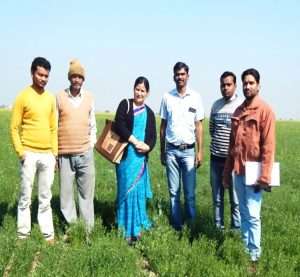 Scientist monitoring the lentil seed production in Jalaun district
Scientist monitoring the lentil seed production in Jalaun district
Commercialization of technologies: On shelf technological options available with the public-funded research system offers tremendous scope for productivity improvement in pulses. This includes improved varieties, crop protection technologies including biocontrol agents, strains of beneficial microorganisms in agriculture, improved farm implements and equipment and so on. Engaging private players for exploring the commercial potential of these technologies could be one of the ways to achieve greater reach among potential users for achieving greater impact.
Farmer led Farmer-to-farmer extension approach(FFE): For achieving speedier diffusion of quality seeds of improved pulse varieties among growers, a farmer led farmer-to-farmer extension approach was validated and leveraged wherein partner farmers may act as change agents for guiding technology demonstrations as well as its dissemination using the existing social network (Box 4).CFLDs (>30,000/year) and FLDs (>1500/year) are massive government-sponsored programs designed for enhancement of pulse production and productivity in India. Up scaling the FFE approach through these programs may lead to enhanced reach of these programs to two-three times the target farmers per year.
| Box 4: FFE approach of ICAR-IIPR ICAR-IIPR validated this approach for pulse crops during 2010-16 through action-oriented experimentation with 143 lead farmers in the Bundelkhand region of UP State, India. The lead farmers were asked to diffuse double the quantity of new pulse seeds provided to them after the harvest to two other farmers in their social network. This approach ensured 3-, 4- and 4-fold increases in coverage of farmers, area sown, and quantity of seeds made accessible to farmers, respectively. |
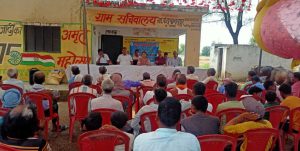 Farmer Scientist Interaction at Ingwara village, KanpurDehat district
Farmer Scientist Interaction at Ingwara village, KanpurDehat district
Community-based extension approach of establishing model pulse villages: Community-based extension approach has also established its worth in improving technological acceptance and higher pulse productivity levels through the field level experimentation in four villages located in major pulse-growing regions of UP State by establishing model pulse villages (Sah et al. 2022). For knowledge empowerment, partner farmers in the model pulse villages were linked to the SMS-based voice advisory service Dalhan Sandesh of ICAR-IIPR for receiving crop-based advisories on real time basis. Horizontal diffusion of 7302 kg seed was facilitated covering 209 ha in 69 adjoining villages. For strengthening farmers’ entrepreneurial activities, they were linked with National Seed Corporation, Uttar Pradesh Seed Certification Agency, local NGOs (for sale of produce), and farmers of other villages.
ENDNOTE
Enhancing production and consumption of pulses can help in achieving the Sustainable Development Goals 2 (End Hunger) and 3 (Good Health and Wellbeing) of the UN. Because of lower water, carbon and energy footprints, pulses add resilience to the production system and thus have a role in achieving SDG 13, that aims to combat climate change and its impacts.
In India, pulses irrevocably, shall remain for years to come one of the major crop components for ensuring human and soil health, improving national economy, fostering natural resources sustainability, and bringing entrepreneurship to India’s rural youth. The fruitful coordination of technology, scale, and government policy shall be instrumental in addressing the challenges discussed earlier. Extension and Advisory Services should play a major role in achieving self-sufficiency in pulses by the end of 2027 as resolved by the Government of India.
References
Gills MS, Prasad K and Ahlawat IPS. 2009. Improving sustainability of rice-wheat croppingsystem through pulses: Weeds and imperatives. Pages 71-91 in Legumes for ecological sustainability(Ali M, Gupta S, Basu PS and Naimuddin, eds.). Indian Society of Pulses Researchand Development, Kanpur.
Ghosh PK, Bandopadhyay KK, Wanjhari RH, Manna MC, Misra AK, MohantyM and Subba Rao A. 2007. Legume Effect for Enhancing Productivity and Nutrient Use-Efficiency in Major Cropping Systems—An Indian Perspective: A Review. Journal of Sustainable Agriculture 30 (1):59-86.
Sah U, Kumar N, Mishra RK, Sujayanand GK, Hussain A, Ojha J and Dubey SK. 2022.Operational framework for development of model pulse village: An action research. Journal of Community Mobilization and Sustainable Development 17(3):1029-1038.
MudryiAN, Yu Nancy, Aukema Harold M. 2014. Nutritional and health benefits of pulses. Appl PhysiolNutrMetab39(11):1197-204. doi: 10.1139/apnm-2013-0557.
Statista (2023) Estimated share of pulses production across India in financial year 2022, by leading state. https://www.statista.com/statistics/984066/share-of-pulses-production-by-state-in-india/
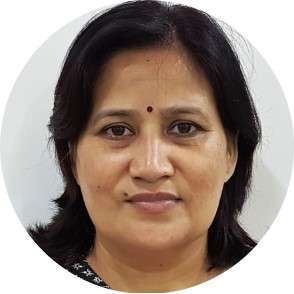 Dr Uma Sah is Head, Division of Social Sciences, ICAR-Indian Institute of Pulses Research, Kanpur, Uttar Pradesh, India. (uma.sah@icar.gov.in)
Dr Uma Sah is Head, Division of Social Sciences, ICAR-Indian Institute of Pulses Research, Kanpur, Uttar Pradesh, India. (uma.sah@icar.gov.in)
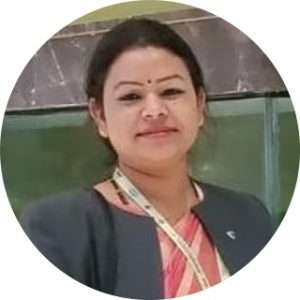 Dr Rekha Rani is a Scientist (Agricultural Economics), ICAR-Indian Institute of Pulses Research, Kanpur, Uttar Pradesh, India. (rekha.rani3@icar.gov.in)
Dr Rekha Rani is a Scientist (Agricultural Economics), ICAR-Indian Institute of Pulses Research, Kanpur, Uttar Pradesh, India. (rekha.rani3@icar.gov.in)

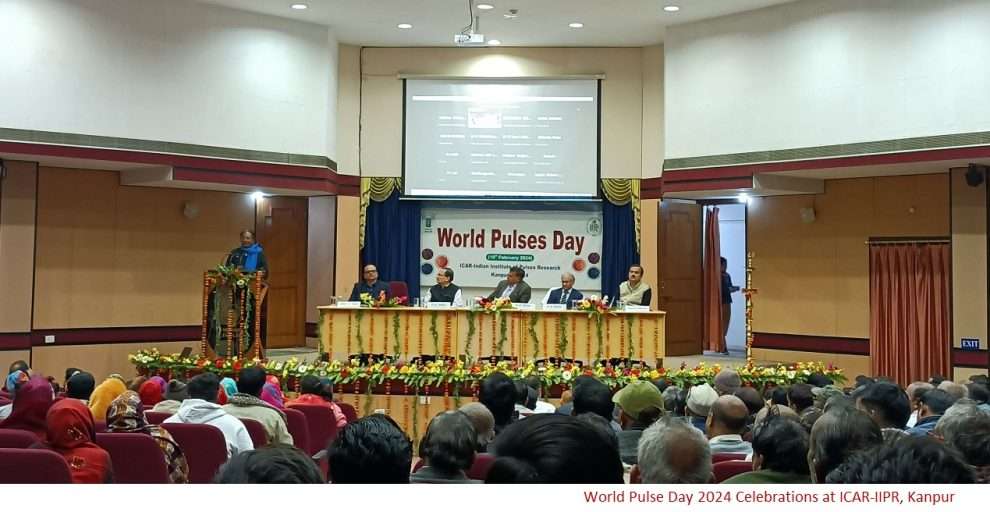

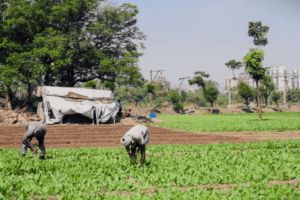

Add Comment